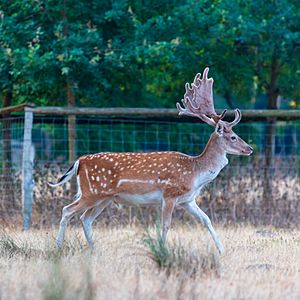Dama (genus) facts for kids
Quick facts for kids Dama (genus) |
|
|---|---|
 |
|
| European fallow deer (D. dama) | |
| Scientific classification |
|
| Kingdom: | Animalia |
| Phylum: | Chordata |
| Class: | Mammalia |
| Order: | Artiodactyla |
| Family: | Cervidae |
| Subfamily: | Cervinae |
| Tribe: | Cervini |
| Genus: | Dama Frisch, 1775 |
| Type species | |
| Cervus dama |
|
| Species | |
|
|
Dama is a group of deer often called fallow deer. These deer belong to the Cervinae family, which includes many types of deer. There are two main kinds of fallow deer alive today. They are known for their beautiful antlers, especially the males.
Contents
What's in a Name?
The name "fallow" comes from the deer's color. They often have a pale brown coat. The scientific name, Dama, comes from an old Latin word. This word, dāma, was used for different animals like roe deer and gazelles.
Many languages have similar names for these deer. For example, in German, they are called Damhirsch. In French, they are daim. In Croatian and Serbian, they are called jelen lopatar. This means "shovel deer" because of the shape of their antlers.
Types of Fallow Deer
The Dama group includes two main types of deer. These are known as species. Sometimes, scientists debate if they are separate species or just different types of the same species.
Living Species of Fallow Deer
Here are the two kinds of fallow deer that are still alive today:
| Image | Scientific Name | Common Name | Where They Live |
|---|---|---|---|
 |
D. dama | European fallow deer | These deer are truly native to Turkey. They might also be native to parts of Italy, the Balkans, and the island of Rhodes in Greece. People have moved them to other parts of Europe and around the world since Roman times. |
 |
D. mesopotamica | Persian fallow deer | You can find these deer in Iran and Israel. Long ago, they lived across the Middle East and eastern Turkey. |
Are They Different Species?
Some scientists think the Persian fallow deer is a type of European fallow deer. They call it a subspecies (D. d. mesopotamica). But other groups, like the IUCN, see it as its own separate species (D. mesopotamica). This means they are different enough to be counted as unique kinds of deer.
See also
 In Spanish: Dama (género) para niños
In Spanish: Dama (género) para niños

